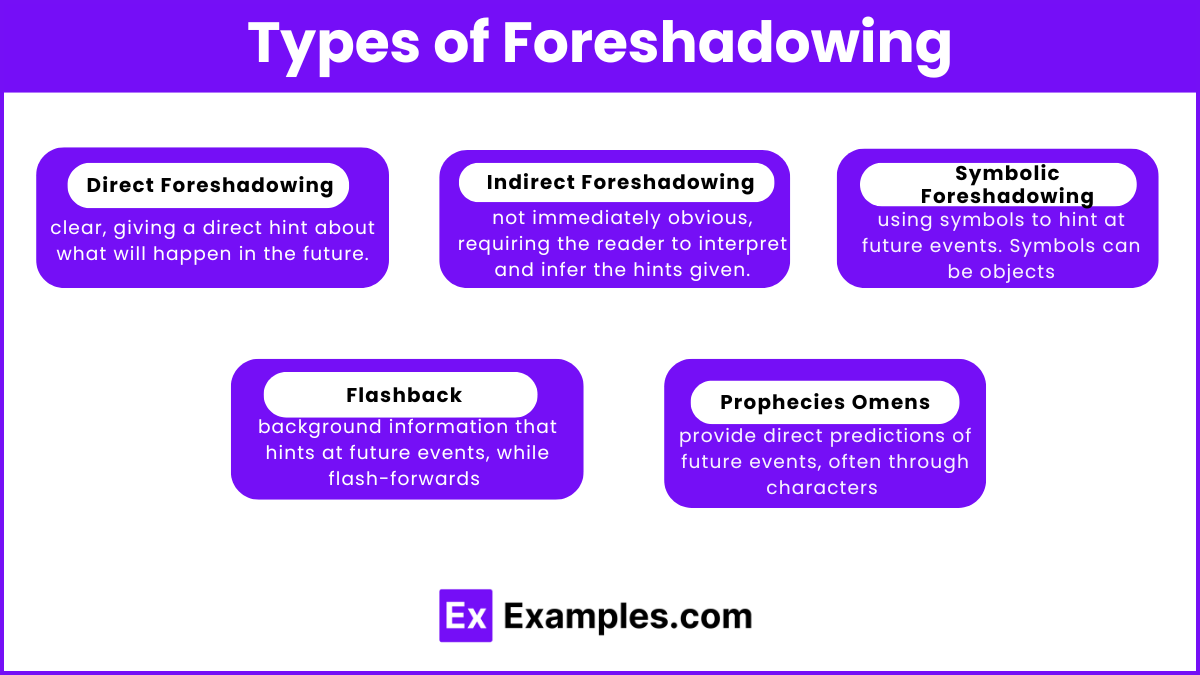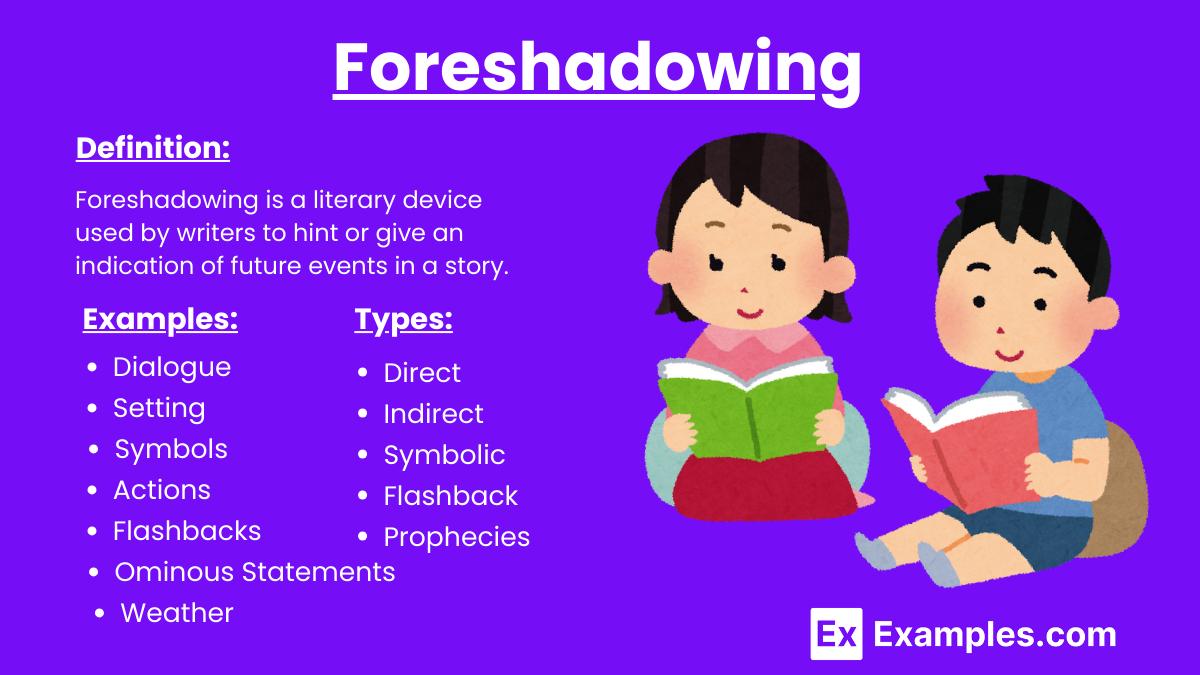20+ Foreshadowing Examples
Foreshadowing is a literary device where the author gives hints or clues about events that will happen later in the story. These hints can be subtle or direct, creating anticipation or suspense and helping to prepare the reader for what is to come. By planting these clues early on, the author can build tension and ensure that the story’s progression feels natural and cohesive. Foreshadowing often enriches the reading experience by allowing the audience to make connections and predictions, which enhances their engagement with the narrative. Unlike flashback, which reveals past events, foreshadowing is a literary technique that looks forward, setting the stage for future developments.
What is Foreshadowing?
Foreshadowing is a literary device used by writers to hint or give an indication of future events in a story. This technique creates anticipation and suspense, preparing readers for what is to come by subtly planting clues and suggestions within the narrative. These hints can be delivered through dialogue, actions, symbols, or even the setting, often adding depth and layers to the plot.
Examples of Foreshadowing
- Dialogue: In Shakespeare’s “Romeo and Juliet,” Romeo says, “My life were better ended by their hate, than death prorogued, wanting of thy love.” This foreshadows the tragic ending where the lovers choose death over living without each other.
- Setting: In “The Great Gatsby” by F. Scott Fitzgerald, the gloomy and desolate Valley of Ashes symbolizes moral decay and foreshadows the tragic events that unfold later in the story.
- Symbols: In “The Hunger Games” by Suzanne Collins, Katniss’s act of volunteering to take her sister’s place foreshadows her protective nature and willingness to sacrifice, which becomes crucial in the story’s climax.
- Actions: In “Of Mice and Men” by John Steinbeck, the shooting of Candy’s old dog foreshadows the novel’s ending, where George must make a similarly difficult decision about Lennie.
- Flashbacks: In “To Kill a Mockingbird” by Harper Lee, early mentions of Boo Radley’s mysterious past foreshadow his crucial role in the climax, saving Scout and Jem.
- Ominous Statements: In J.K. Rowling’s “Harry Potter and the Sorcerer’s Stone,” Professor Trelawney’s vague predictions about Harry’s future foreshadow the dangerous encounters and ultimate showdown with Voldemort.
- Weather: In “Wuthering Heights” by Emily Brontë, the stormy weather often foreshadows turbulent and tragic events in the story, such as Heathcliff’s return and ensuing chaos.
- Dreams: In “Julius Caesar” by Shakespeare, Calpurnia’s dream of Caesar’s statue spouting blood foreshadows his assassination.
Foreshadowing Examples in Literature
- “Romeo and Juliet” by William Shakespeare
- Explanation: Early hints of a tragic ending create a sense of impending doom.
- Example: Romeo says, “My mind misgives some consequence yet hanging in the stars.”
- “The Great Gatsby” by F. Scott Fitzgerald
- Explanation: The recurring symbol of the green light represents Gatsby’s unattainable dream and hints at his ultimate failure.
- Example: Gatsby’s fixation on the green light at the end of Daisy’s dock.
- “Of Mice and Men” by John Steinbeck
- Explanation: The death of Candy’s dog foreshadows a similar fate for Lennie, showing the harsh reality of their world.
- Example: Candy’s old dog is shot because it is considered useless.
- “Macbeth” by William Shakespeare
- Explanation: The witches’ prophecies hint at Macbeth’s rise to power and eventual downfall.
- Example: The witches predict that Macbeth will become king, but their prophecies also contain clues about his demise.
- “To Kill a Mockingbird” by Harper Lee
- Explanation: Early descriptions of Boo Radley create an aura of mystery and suspense, foreshadowing his later involvement in the story.
- Example: Scout describes Boo Radley’s reclusive and mysterious nature early in the novel.
- “The Hunger Games” by Suzanne Collins
- Explanation: Katniss’s selfless act of volunteering for her sister hints at her protective nature and leadership qualities.
- Example: Katniss volunteers to take Prim’s place in the Hunger Games.
- “Julius Caesar” by William Shakespeare
- Explanation: Calpurnia’s ominous dreams and warnings hint at the forthcoming assassination of Caesar.
- Example: Calpurnia dreams of Caesar’s statue spouting blood, which foreshadows his murder.
- “Wuthering Heights” by Emily Brontë
- Explanation: The stormy weather often reflects the turbulent events and emotional turmoil in the novel.
- Example: A violent storm occurs on the night Heathcliff returns, foreshadowing the chaos he brings.
Foreshadowing Examples for kids
- “The Lion King”
- Explanation: Early in the movie, Scar’s sinister behavior and the way he talks about power hint at his plans to overthrow Mufasa.
- Example: Scar says, “I’m surrounded by idiots,” which shows his disdain and foreshadows his betrayal.
- “Charlotte’s Web” by E.B. White
- Explanation: Charlotte’s initial efforts to save Wilbur hint at her ultimate plan to weave words into her web.
- Example: When Charlotte says she’s going to help Wilbur, it foreshadows her creative plan to write messages in her web to save him.
- “Harry Potter and the Sorcerer’s Stone” by J.K. Rowling
- Explanation: Early mentions of Harry’s scar hurting when Voldemort is near foreshadow the connection between them.
- Example: Harry’s scar hurts when he first meets Professor Quirrell, hinting at Quirrell’s connection to Voldemort.
- “Finding Nemo”
- Explanation: Marlin’s constant worry and overprotectiveness foreshadow the adventure and dangers that Nemo will face.
- Example: Marlin’s warning, “It’s like he’s trying to swim out to the ocean!” foreshadows Nemo’s actual escape to the open sea.
- “Frozen”
- Explanation: Elsa’s struggle to control her powers hints at the significant impact her abilities will have on the kingdom.
- Example: Elsa accidentally reveals her powers during her coronation, foreshadowing the challenges she will face as queen.
- “The Lorax” by Dr. Seuss
- Explanation: The Once-ler’s actions of cutting down trees despite warnings foreshadow the environmental destruction that follows.
- Example: The Lorax saying, “I speak for the trees,” hints at the eventual disappearance of the forest due to the Once-ler’s greed.
- “Toy Story”
- Explanation: Woody’s jealousy of Buzz Lightyear hints at the conflict and eventual teamwork that will develop between them.
- Example: Woody’s initial reaction to Buzz, feeling threatened and insecure, foreshadows their eventual rivalry and cooperation.
Types of Foreshadowing

- Direct Foreshadowing (Overt Foreshadowing)
- Explanation: This type is explicit and clear, giving a direct hint about what will happen in the future.
- Example: In “Romeo and Juliet,” the chorus at the beginning of the play directly states that the lovers are “star-crossed” and doomed to die.
- Indirect Foreshadowing (Covert Foreshadowing)
- Explanation: This type is subtle and not immediately obvious, requiring the reader to interpret and infer the hints given.
- Example: In “Harry Potter and the Sorcerer’s Stone,” the repeated mention of Harry’s scar hurting around Professor Quirrell indirectly hints at Quirrell’s connection to Voldemort.
- Symbolic Foreshadowing
- Explanation: This involves using symbols to hint at future events. Symbols can be objects, colors, or even weather.
- Example: In “The Great Gatsby,” the green light at the end of Daisy’s dock symbolizes Gatsby’s unattainable dreams and foreshadows his eventual failure to achieve them.
- Flashback/Flash-forward
- Explanation: Flashbacks provide background information that hints at future events, while flash-forwards give glimpses of events that will happen later.
- Example: In “A Christmas Carol” by Charles Dickens, Scrooge’s flashbacks to his lonely childhood and lost love foreshadow his need to change his ways.
- Prophecies and Omens
- Explanation: Prophecies and omens provide direct predictions of future events, often through characters like witches, seers, or supernatural elements.
- Example: In “Macbeth,” the witches’ prophecies explicitly foreshadow Macbeth’s rise to power and his eventual downfall.
Uses of Foreshadowing
- Building Suspense: Foreshadowing creates anticipation and tension by giving readers subtle hints about future events, making them eager to find out what happens next.
- Enhancing the Narrative: It adds depth to the storyline, making it more engaging and layered by providing clues that connect different parts of the story.
- Creating Cohesion: Foreshadowing links early parts of the story to later developments, ensuring that the plot feels well-structured and interconnected.
- Developing Themes: By hinting at future events, authors can reinforce the central themes of the story, making them more impactful and resonant.
- Deepening Character Development: It can provide insights into a character’s future actions or decisions, making their behavior more believable and well-motivated.
- Enhancing Reader Engagement: Readers become more invested in the story as they try to piece together the foreshadowed hints, making the reading experience more interactive and immersive.
Synonyms for Foreshadowing
| Synonyms | Synonyms |
|---|---|
| Prefiguring | Forewarning |
| Foretelling | Presaging |
| Hinting | Auguring |
| Predicting | Indicating |
| Anticipating | Portending |
| Prophesying | Signaling |
| Harbingering | Heralding |
| Suggesting | Implying |
How to Pronounce Foreshadow
Foreshadow is a common literary term used in English, often seen in both spoken and written contexts. Here’s how you can pronounce it correctly.
Pronunciation Guide
- Break Down the Word:
- Fore: Sounds like “four” (/fɔːr/).
- Shadow: Sounds like “shad-oh” (/ˈʃæd.oʊ/).
- Combine the Sounds:
- Foreshadow: /fɔːrˈʃæd.oʊ/
Steps to Pronounce “Foreshadow”
- Start with “Fore”:
- Say “four” but without emphasizing the “u” sound. It should be quick and smooth.
- Move to “Shadow”:
- Begin with “shad” where the “sh” sounds like the beginning of “shoe” and “ad” rhymes with “had”.
- End with “ow” which sounds like the beginning of “owe”.
- Practice the Whole Word:
- Foreshadow: Say “four” quickly followed by “shad-oh”.
Phonetic Breakdown
- “Fore”: /fɔːr/
- “Shadow”: /ˈʃæd.oʊ/
When spoken together: /fɔːrˈʃæd.oʊ/
FAQ’s
Why do authors use foreshadowing?
Authors use foreshadowing to build suspense, create anticipation, and prepare readers for future events, making the story more engaging.
How does foreshadowing enhance a story?
Foreshadowing enhances a story by creating suspense, connecting plot elements, and adding depth to the narrative.
What are common methods of foreshadowing?
Common methods include dialogue, setting, symbolism, and character actions or thoughts that hint at future events.
Is foreshadowing always obvious?
No, foreshadowing can be subtle or direct, depending on the author’s intent and the story’s needs.
How can you identify foreshadowing in a text?
Identify foreshadowing by looking for hints, clues, or recurring themes that suggest future plot developments.
What is the difference between foreshadowing and a flashback?
Foreshadowing hints at future events, while a flashback reveals past events to provide context or background.
Can foreshadowing be misleading?
Yes, sometimes authors use red herrings, misleading hints, to divert attention from the true outcome.
How does foreshadowing relate to dramatic irony?
Foreshadowing and dramatic irony both create anticipation; dramatic irony occurs when the audience knows more than the characters, enhancing the impact of foreshadowed events.
What role does foreshadowing play in mysteries?
In mysteries, foreshadowing plants clues that help readers piece together the puzzle and anticipate the resolution.
an foreshadowing be used in non-fiction?
Yes, non-fiction writers use foreshadowing to hint at future developments, keeping readers engaged and curious.



